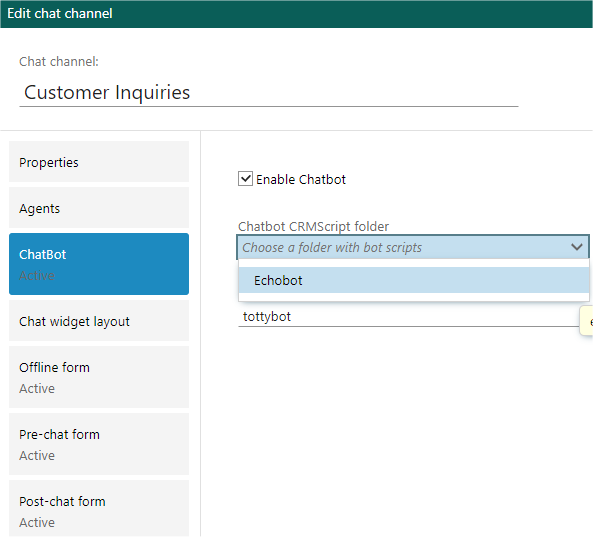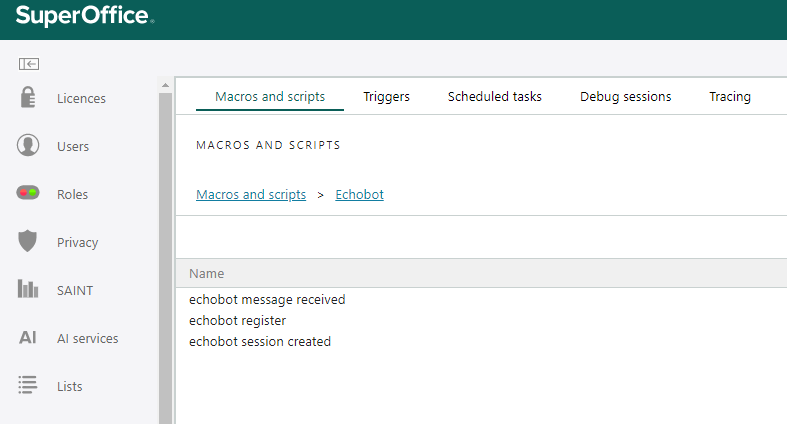Chatbot overview
Chatbot needs AI License
Chatbot functionality in SuperOffice requires the AI Platform license and the Chatbot Connector license. This enables the Chatbot tab in chat administration.

CRMScripts
Chatbots are folders that contain one or more CRMScripts with names that fit a pattern:
...bot register...signals the presence of a chatbot in the folder....bot session create...is called when a new chat session starts....bot session change...is called when the chat session changes state....bot message receive...is called when a new message is received.
The names of the scripts must follow this pattern, but they allow any prefix or suffix you want. echobot register, my bot registered, and BotRegister are all acceptable names for the registration script.
The CRMScripts are not called after the chatbot hands the session off to the queue for human processing. The bot message receive script is only called for incoming messages.
This removes the need for a bunch of book-keeping logic, simplifying the bot scripts.

The name of the folder is shown in the chatbot picker.
The chatbot scripts are called when events happen:

When a session starts on a channel with a chatbot:
- First the
bot session createscript is called. - Then the
bot session changescript may be called if there is a pre-chat form or faq suggestion. - Then the
bot message receivescript is called once for each message received from the customer. - Then the
bot session changescript is called when the session state changes. - Then the
bot message receivescript is called once for each message received from the customer. - Repeat until completed or handed off to queue for processing.
A script can hand off a chat session to a human by calling resetChat(sessionId). This will tag the session with botIsActive = false so that the bot scripts are no longer called.
A script can end a session by setting it to closed: setChatStatus(sessionId, 7); (7 = closed).
Alternatives
Chatbot requires an AI license, which is only available online. On-site customers need to look at alternative approaches.
CrmScripts Triggers
Without the AI license you can still make chatbots, it is just a bit harder.
There are corresponding triggers that you can create scripts for:
- Chat Session Created
- Chat Session Changed
- Chat Message Received/Sent
Unlike the chatbot scripts, these triggers apply to all chat channels and all chat messages, so you need to do more filtering to make the chatbot work only on specific channels.
Webhooks
There are webhook events that are fired that correspond to the CRMScript triggers.
These events are fired when chat sessions and messages change:
chatsession.created- new session startschatsession.changed- session has changed statechatsession.message- new message added to chat session
You would need to use the REST API to read the latest messages in the session and figure out what to do.
GET /api/v1/ChatSession/{chatSessionId}/Messages
Like the triggers, the webhooks apply to all chat channels and messages, not just the ones with a bot configured.
You would use the REST API to post messages to a chat session.
POST /api/v1/ChatSession/{chatSessionId}/Messages
Examples
A full set of chatbot examples can be found on GitHub SuperOffice/devnet-CRMScript-chatbot
- Echo bot: just mirrors the user's input back. Overrides pre-chat form.
- Echo bot 2: just mirrors the user's input back, but shows pre-chat form first.
- Dad joke bot: answers with a new joke from a web service.
- Botkit bot: talks to a simple bot service implemented using
botkit.ai. - Azure bot: uses the Azure bot platform to analyze messages and respond with intents.
- Google Dialogflow bot: uses Google's bot platform to analyze messages and respond with intents.